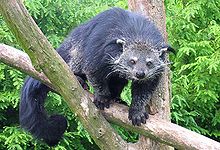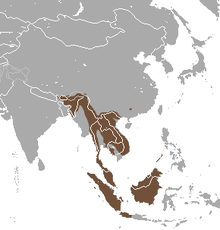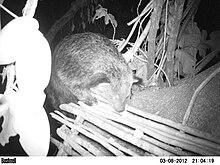Black Animal With Snout Looks Like Cat
Black Animal With Snout Looks Like Cat
| Binturong | |
|---|---|
 | |
| Scientific classification | |
| Kingdom: | Animalia |
| Phylum: | Chordata |
| Class: | Mammalia |
| Club: | Carnivora |
| Suborder: | Feliformia |
| Family: | Viverridae |
| Subfamily: | Paradoxurinae |
| Genus: | Arctictis Temminck, 1824 |
| Species: | A. binturong [1] |
| Binomial name | |
| Arctictis binturong [1] (Raffles, 1822) | |
 | |
| Binturong range | |
The binturong (Arctictis binturong) (, bin-TURE-ong, BIN-ture-ong ), also known as the bearcat, is a viverrid native to Due south and Southeast Asia. Information technology is uncommon in much of its range, and has been assessed every bit Vulnerable on the IUCN Red List considering of a failing population trend that is estimated at more than 30% since the mid 1980s. [2] The binturong is the only living species in the genus Arctictis.
Taxonomy [ edit ]
Viverra binturong was the scientific name used past Thomas Stamford Raffles in 1822 for a binturong collected in Malacca. [3] The scientific name of the genus Arctictis was coined past Coenraad Jacob Temminck in 1824. [4] Arctictis is a monotypic taxon; its morphology is similar to that of members of the genera Paradoxurus and Paguma . [5]
Etymology [ edit ]
The name Arctictis means 'bear-weasel', from Greek arkt- 'bear' + iktis 'weasel'. [half dozen] In Riau, Indonesia it is called 'benturong' and 'tenturun'. [7] Its mutual proper noun in Borneo is "binturong", which is related to the Western Malayo-Polynesian root "ma-tuRun". [8]
Characteristics [ edit ]
Skull and dentition of the binturong, as illustrated in Paul Gervais' Histoire naturelle des mammifères
The binturong is long and heavy, with short, stout legs. It has a thick coat of coarse black hair. The bushy and prehensile tail is thick at the root, gradually tapering, and curls inwards at the tip. The muzzle is short and pointed, somewhat turned up at the nose, and is covered with bristly hairs, brown at the points, which lengthen every bit they diverge, and form a peculiar radiated circle round the confront. The eyes are large, blackness and prominent. The ears are short, rounded, edged with white, and terminated past tufts of black hair. There are six short rounded incisors in each jaw, two canines, which are long and sharp, and vi molars on each side. The hair on the legs is brusk and of a yellowish tinge. The feet are five-toed, with large strong claws; the soles are bare, and practical to the basis throughout the whole of their length; the hind ones are longer than the fore ones. [3]
In general build the binturong is essentially like Paradoxurus and Paguma, but more massive in the length of the tail, legs and feet, in the construction of the scent glands and larger size of the rhinarium, which is more convex with a median groove being much narrower above the philtrum. The contour hairs of the coat are much longer and coarser, and the long hairs clothing the whole of the back of the ears project across the tip as a definite tuft. The inductive bursa flap of the ears is more than widely and less deeply emarginate. The tail is more muscular, especially at the base, and in colour mostly like the body, but commonly paler at the base of operations below. The body hairs are frequently partly whitish or buff, giving a speckled advent to the pelage, sometimes and so pale that the whole body is generally straw-coloured or grey, the immature being often at all events paler than the adults, simply the head is ever closely speckled with greyness or buff. The long mystacial vibrissae are conspicuously white, and in that location is a white rim on the summit of the otherwise black ear. The glandular area is whitish. [5]
The tail is nearly every bit long as the caput and body, which ranges from 71 to 84 cm (28 to 33 in); the tail is 66 to 69 cm (26 to 27 in) long. [nine] Some captive binturongs measured from 75 to 90 centimetres (30–35 in) in head and torso with a tail of 70 cm (two ft 4 in). [10] Mean weight of convict adult females is 21.ix kg (48 lb 4 oz) with a range from 11 to 32 kg (24 to 71 lb). Captive animals often weigh more than wild counterparts. [eleven] 12 captive female binturongs were found to weigh a mean of 24.4 kg (53 lb xiii oz) while 22 males weighed a mean of xix.3 kg (42 lb 9 oz). [12] The estimated mean weight of wild females per ane study was 10.5 kg (23 lb 2 oz). [11] Notwithstanding, seven wild male person binturongs in Thailand were establish to counterbalance a mean of 13.3 kg (29 lb 5 oz), while one female was of like weight at 13.five kg (29 lb 12 oz). [13] I guess of the mean body mass of wild binturongs was fifteen kg (33 lb). [14] The binturong appears to be the largest species of the viverrid family, rivaled only past the African civet, which weighs a mean of nearly 11.three kg (24 lb 15 oz). [15] [16] [17]
Both sexes have aroma glands; females on either side of the vulva, and males between the scrotum and penis. [xviii] [19] The musk glands emit an olfactory property reminiscent of popcorn or corn fries, probable due to the volatile compound 2-acetyl-one-pyrroline in the urine, which is too produced in the Maillard reaction at loftier temperatures. [xx] Dissimilar most other carnivorans, the male binturong does not accept a baculum. [21]
Distribution and habitat [ edit ]
The binturong occurs from India, Nepal, Bangladesh, Kingdom of bhutan, Myanmar, Thailand, Malaysia to Laos, Cambodia, Vietnam and Yunnan in China, and Sumatra, Kalimantan and Java in Indonesia to Palawan in the Philippines. [ii] It is confined to tall forest. [22] In Assam, it is common in foothills and hills with good tree cover, but less so in the forested plains. It has been recorded in Manas National Park, in Dulung and Kakoi Reserved Forests of the Lakhimpur district, in the loma forests of Karbi Anglong, North Cachar Hills, Cachar and Hailakandi Districts. [23] In Myanmar, binturongs were photographed on the ground in Tanintharyi Nature Reserve at an elevation of 60 1000 (200 ft), in the Hukaung Valley at elevations from 220–280 m (720–920 ft), in the Rakhine Yoma Elephant Reserve at 580 m (1,900 ft) and at iii other sites up to 1,190 m (3,900 ft) summit. [24] In Thailand's Khao Yai National Park, several individuals were observed feeding in a fig tree and on a vine. [25] In Lao people's democratic republic, they take been observed in all-encompassing evergreen forest. [26] In Malaysia, binturongs were recorded in secondary forest surrounding a palm estate that was logged in the 1970s. [27] In Palawan, it inhabits main and secondary lowland forest, including grassland–forest mosaic from ocean level to 400 m (i,300 ft). [28]
Taxonomy [ edit ]
Viverra binturong was the scientific proper name proposed by Thomas Stamford Raffles in 1822 for a specimen from Malacca. [three] The generic name Arctictis was proposed by Coenraad Jacob Temminck in 1824. [29] In the 19th and 20th centuries, the following zoological specimens were described: [30]
- Paradoxurus albifrons proposed by Frédéric Cuvier in 1822 was based on a drawing of a binturong from Bhutan prepared by Alfred Duvaucel. [31]
- Arctictis penicillata by Temminck in 1835 were specimens from Sumatra and Java. [32]
- Arctictis whitei proposed past Joel Asaph Allen in 1910 were skins of two female binturongs collected in Palawan Isle in the Philippines. [33]
- Arctictis pageli proposed past Ernst Schwarz in 1911 was a peel and skull of a female person nerveless in northern Borneo. [34]
- Arctictis gairdneri proposed by Oldfield Thomas in 1916 was a skull of a male binturong nerveless in southwestern Thailand. [35]
- Arctictis niasensis proposed by Marcus Ward Lyon Jr. in 1916 was a binturong skin from Nias Island. [36]
- A. b. kerkhoveni by Henri Jacob Victor Sody in 1936 was based on specimens from Bangka Isle. [37]
- A. b. menglaensis by Wang and Li in 1987 was based on specimens from the Yunnan Province in China. [38]
Nine subspecies have been recognized forming two clades. The northern clade in mainland Asia is separated from the Sundaic clade past the Isthmus of Kra. [38]
Ecology and beliefs [ edit ]
Binturong photographed past a camera trap at a feeding platform on a fruiting Ficus
The binturong is agile during the day and at night. [25] [26] Three sightings in Pakke Tiger Reserve were by day. [39] Thirteen camera trap photograph events in Myanmar involved one around dusk, vii in full night and five in broad daylight. All photographs were of unmarried animals, and all were taken on the footing. As binturongs are not very nimble, they may have to descend to the ground relatively frequently when moving between trees. [24]
V radio-collared binturongs in the Phu Khieo Wild animals Sanctuary exhibited an arrhythmic action dominated by crepuscular and nocturnal tendencies with peaks in the early morn and belatedly evening. Reduced inactivity periods occurred from midday to tardily afternoon. They moved between 25 thou (82 ft) and 2,698 m (eight,852 ft) daily in the dry out season and increased their daily move to four,143 m (thirteen,593 ft) in the wet season. Ranges sizes of males varied betwixt 0.9 and vi.1 km2 ( 3⁄eight and 2+ iii⁄8 sq mi). Two males showed slightly larger ranges in the wet season. Their ranges overlapped betwixt 30 and 70%. [fourteen] The average home range of a radio-collared female person in the Khao Yai National Park was estimated at 4 km2 (1+ 1⁄2 sq mi), and the ane of a male at 4.5 to 20.5 kmii (1+ 3⁄4 to eight sq mi). [40]
The binturong is essentially arboreal. Pocock observed the behaviour of several captive individuals in the London Zoological Gardens. When resting they lie curled up, with the head tucked under the tail. They seldom leaped, but climbed skillfully, albeit slowly, progressing with equal ease and confidence forth the upper side of branches or, upside downwards, below them. The prehensile tail was always ready as a help. They descended the vertical bars of the cage head first, gripping them between their paws and using the prehensile tail every bit a check. When irritated they growled fiercely. When on the cruise they periodically uttered a series of low grunts or a hissing sound fabricated by expelling air through partially opened lips. [5]
The binturong uses its tail to communicate. [18] It moves about gently, ofttimes coming to a stop, and oftentimes using the tail to go along rest, clinging to a branch. It shows a pronounced condolement behaviour associated with grooming the fur, shaking and licking the hair, and scratching. Shaking is the well-nigh characteristic chemical element of comfort behaviour. [41]
The species is normally quite shy, merely ambitious when harassed. It is reported to initially urinate or defecate on a threat and and so, if teeth-baring and snarling does not deter the threat, it uses its powerful jaws and teeth in self-defense. When threatened, the binturong volition ordinarily flee into a nearby tree, but as a defense force machinery the binturong may sometimes residual on its tail and flash its claws to appear threatening to potential predators. Predation on developed binturong is reportedly quite rare by sympatric species like the leopard, clouded leopard and reticulated python. [42]
Diet [ edit ]
The binturong is omnivorous, feeding on small-scale mammals, birds, fish, earthworms, insects and fruits. [9] Information technology likewise preys on rodents. [22] Fish and earthworms are likely unimportant items in its diet, equally it is neither aquatic nor fossorial, coming across such prey only when opportunities present themselves. Since it does not take the attributes of a predatory mammal, most of the binturong's diet is probably of vegetable matter. [5] Figs are a major component of its diet. [25] [39] [43] Captive binturongs are specially fond of plantains, but as well eat fowls' heads and eggs. [3]
The binturong is an of import agent for seed dispersal, especially for those of the strangler fig, because of its power to scarify the seed'south tough outer covering. [44]
In captivity, the binturong's diet includes commercially prepared meat mix, bananas, apples, oranges, canned peaches and mineral supplement. [11]
Reproduction [ edit ]
The boilerplate age of sexual maturation is 30.4 months for females and 27.7 months for males. The estrous cycle of the binturong lasts 18 to 187 days, with an boilerplate of 82.5 days. Gestation lasts 84 to 99 days. Litter size in captivity varies from one to half-dozen young, with an average of two young per birth. Neonates counterbalance betwixt 280 and 340 one thousand (x and 12 oz), and are oft referred to equally shruggles.[ commendation needed ] Fertility lasts until xv years of age. [xi]
The maximum known lifespan in captivity is idea to be over 25 years of historic period. [45]
Threats [ edit ]
Major threats to the binturong are habitat loss and degradation of forests through logging and conversion of forests to non-forest country-uses throughout the binturong's range. Habitat loss has been severe in the lowlands of the Sundaic part of its range, and in that location is no evidence that the binturong uses the plantations that are largely replacing natural forest. In China, rampant deforestation and opportunistic logging practices have fragmented suitable habitat or eliminated sites altogether. In the Philippines, it is captured for the wildlife merchandise, and in the south of its range it is also taken for human consumption. In Laos, information technology is one of the most frequently displayed caged alive carnivores and skins are traded frequently in at least Vientiane. In parts of Laos, it is considered a delicacy and likewise traded equally a food item to Vietnam. [2]
The Orang Asli of Malaysia has the tradition of keeping binturongs as pets. [46] [47]
Conservation [ edit ]
India included the binturong in CITES Appendix III and in Schedule I of the Wild Life Protection Human activity 1973, so that it has the highest level of protection. In Red china, it is listed as critically endangered. It is completely protected in Bangladesh, and partially in Thailand, Malaysia, and Vietnam. Licensed hunting of binturong is immune in Indonesia, and it is non protected in Negara brunei darussalam. [ii]
World Binturong Day, an issue defended to binturong awareness and conservation, takes identify yearly every second Sat of May. [48]
In captivity [ edit ]
Binturongs are common in zoos, and captive individuals represent a source of genetic diversity essential for long-term conservation. Their geographic origin is either usually unknown, or they are offspring of several generations of convict-bred animals. [38]
References [ edit ]
- ^ Wozencraft, W. C. (2005). "Species Arctictis binturong". In Wilson, D. Due east.; Reeder, D. K. (eds.). Mammal Species of the World: A Taxonomic and Geographic Reference (3rd ed.). Johns Hopkins Academy Press. p. 549. ISBN 978-0-8018-8221-0 . OCLC62265494.
- ^ a b c d e Willcox, D.H.A.; Chutipong, W.; Gray, T.N.E.; Cheyne, S.; Semiadi, One thousand.; Rahman, H.; Coudrat, C.Northward.Z.; Jennings, A.; Ghimirey, Y.; Ross, J.; Fredriksson, G.; Tilker, A. (2016). "Arctictis binturong". IUCN Cherry List of Threatened Species . 2016: due east.T41690A45217088. doi: x.2305/IUCN.UK.2016-1.RLTS.T41690A45217088.en . Retrieved 20 November 2022.
- ^ a b c d Raffles, T. S. (1822). "XVII. Descriptive Catalogue of a Zoological Collection, fabricated on account of the Honourable East India Company, in the Island of Sumatra and its Vicinity, under the Direction of Sir Thomas Stamford Raffles, Lieutenant-Governor of Fort Marlborough, with additional Notices illustrative of the Natural History of those Countries". The Transactions of the Linnean Society of London. 13: 239–274.
- ^ Temminck, C. R. (1824). "Tableau Méthodique". Monographie des Mammifères. Paris, Amsterdam: G. Dufour et D'Ocagne, Maison de Commerce. p. XXI.
- ^ a b c d Pocock, R. I. (1939). "Genus Arctictis Temminck". The fauna of British Republic of india, including Ceylon and Burma. Vol.Mammalia. – Volume i. London: Taylor and Francis. pp. 431–439.
- ^ Scherren, H. (1902). "arc-tic-tis". The Encyclopædic Dictionary. London: Cassell and Company. p. 54.
- ^ Wilkinson, R.J. (1901). "tenturun". A Malay-English lexicon. Hongkong, Shanghai and Yokohama: Kelly & Walsh Limited. p. 192.
- ^ Smith, A.D. (2017). "The Western Malayo-Polynesian Problem". Oceanic Linguistics. 56 (2): 435–490. doi:10.1353/ol.2017.0021.
- ^ a b Blanford, West. T. (1888–91). "57. Arctictis binturong". The Animal of British Bharat, including Ceylon and Burma. Mammalia. London: Taylor and Francis. pp. 117–119.
- ^ Arivazhagan, C. & Thiyagesan, Grand. (2001). "Studies on the Binturongs (Arctictis binturong) in captivity at the Arignar Anna Zoological Park, Vandalur". Zoos' Print Periodical. 16 (1): 395–402. doi: 10.11609/JoTT.ZPJ.xvi.1.395-402 .
- ^ a b c d Wemmer, C.; J. Murtaugh (1981). "Copulatory Behavior and Reproduction in the Binturong, Arctictis binturong" (PDF). Journal of Mammalogy. 62 (2): 342–352. doi: ten.2307/1380710 . JSTOR1380710.
- ^ Moresco, A., & Larsen, R. S. (2003). Medetomidine–ketamine–butorphanol anesthetic combinations in binturongs (Arctictis binturong). Journal of Zoo and Wildlife Medicine, 34(4), 346-351.
- ^ Grassman, Fifty. I.; Janecka, J. E.; Austin, South. C.; Tewes, G. E. & Silvy, Northward. J. (2006). "'Chemic immobilization of gratuitous-ranging dhole (Cuon alpinus), binturong (Arctictis binturong), and yellow-throated marten (Martes flavigula) in Thailand". European Journal of Wild animals Enquiry. 52 (4): 297–300. doi:10.1007/s10344-006-0040-eight. S2CID46658064.
- ^ a b Grassman, L. I. Jr.; Tewes, G. E.; Silvy, N. J. (2005). "Ranging, habitat employ and activity patterns of binturong Arctictis binturong and xanthous-throated marten Martes flavigula in northward-fundamental Thailand" (PDF). Wild animals Biology. eleven (one): 49–57. doi:x.2981/0909-6396(2005)11[49:RHUAAP]2.0.CO;two.
- ^ Roots, C. (2006). Nocturnal animals. Greenwood Publishing Group.
- ^ White, 50.J.T. (1994) Biomass of rain forest mammals in the Lope´ Reserve, Gabon. J. Anim. Ecol. 63, 449–512.
- ^ Hunter, 50. (2022). Carnivores of the earth (Vol. 117). Princeton Academy Press.
- ^ a b Story, H. East. (1945). "The External Genitalia and Perfume Gland in Arctictis binturong". Journal of Mammalogy. 26 (1): 64–66. doi:10.2307/1375032. JSTOR1375032.
- ^ Kleiman, D. K. (1974). "Odor marking in the binturong, Arctictis binturong" (PDF). Journal of Mammalogy. 55 (1): 224–227. doi:x.2307/1379278. JSTOR1379278.
- ^ Greene, L. K.; Wallen, T. W.; Moresco, A.; Goodwin, T. Eastward. & Drea, C. M. (2016). "Reproductive endocrine patterns and volatile urinary compounds of Arctictis binturong: discovering why bearcats smell like popcorn". The Science of Nature. 103 (5–6): 37. Bibcode:2016SciNa.103...37G. doi:10.1007/s00114-016-1361-4. PMID27056047. S2CID16439829.
- ^ Schultz, Nicholas G.; Lough-Stevens, Michael; Abreu, Eric; Orr, Teri; Dean, Matthew D. (2016-06-01). "The Baculum was Gained and Lost Multiple Times during Mammalian Evolution". Integrative and Comparative Biology. 56 (4): 644–56. doi:10.1093/icb/icw034. ISSN1540-7063. PMC 6080509 . PMID27252214.
- ^ a b Lekalul, B.; McNeely, J. A. (1977). Mammals of Thailand. Bangkok: Association for the Conservation of Wildlife.
- ^ Choudhury, A. (1997). "The distribution and condition of pocket-sized carnivores (mustelids, viverrids, and herpestids) in Assam, India" (PDF). Small Carnivore Conservation. 16: 25–26. Archived from the original (PDF) on 2015-01-29.
- ^ a b Than Zaw, Saw Htun, Saw Htoo Tta Po, Myint Maung, Lynam, A. J., Kyaw Thinn Latt and Duckworth, J. West. (2008). "Status and distribution of small carnivores in Myanmar" (PDF). Small Carnivore Conservation (38): 2–28. Archived from the original (PDF) on 2015-04-28.
{{cite journal}}: CS1 maint: multiple names: authors list (link) - ^ a b c Nettlebeck, A. R. (1997). "Sightings of Binturongs Arctictis binturong in the Khao Yai National Park, Thailand" (PDF). Pocket-sized Carnivore Conservation (xvi): 21–24. Archived from the original (PDF) on 2015-01-29.
- ^ a b Duckworth, J. W. (1997). "Small carnivores in Laos: a condition review with notes on ecology, behaviour and conservation" (PDF). Small Carnivore Conservation (16): 1–21. Archived from the original (PDF) on 2015-01-29.
- ^ Azlan, J. M. (2003). "The diversity and conservation of mustelids, viverrids, and herpestids in a disturbed forest in Peninsular Malaysia" (PDF). Small-scale Carnivore Conservation (29): 8–9. Archived from the original (PDF) on 2015-01-29.
- ^ Rabor, D. Southward. (1986). Guide to the Philippine flora and fauna. Manila: Natural Resources Management Centre, Ministry of Natural Resources and University of the Philippines.
- ^ Temminck, C. J. (1824). "XVII Genre Arctictis". Monographies de mammalogie. Paris: Dufour & d'Ocagne. p. xxi.
- ^ Ellerman, J. R.; Morrison-Scott, T. C. S. (1966). "Genus Arctictis. Temminck, 1824". Checklist of Palaearctic and Indian mammals 1758 to 1946 (Second ed.). London: British Museum of Natural History. p. 290.
- ^ Cuvier, F. (1822). "Benturong". In Geoffroy Saint-Hilaire, East.; Cuvier, F. (eds.). Histoire naturelle des mammifères : avec des figures originales, coloriées, dessinées d'aprèsdes animaux vivans. Vol. 5. Paris: A. Belin.
- ^ Temminck, C. J. (1835). "Arcticte Binturong – Arctictis binturong". Monographies de Mammalogie. Vol. II. Paris, Leiden: Dufour, Van der Hoek. pp. 308–311.
- ^ Allen, J. A. (1910). "Mammals from Palawan Island, Philippine Islands" (PDF). Bulletin of the American Museum of Natural History. 28: xiii–17.
- ^ Schwarz, E. (1911). "Seven new Asiatic mammals with Annotation on the Viverra fasciata of Gmelin". The Annals and Magazine of Natural History; Zoology, Botany, and Geology. 8. 7 (37): 634–640. doi:10.1080/00222931108692986.
- ^ Thomas, O. (1916). "A new Binturong from Siam". The Register and Magazine of Natural History; Zoology, Phytology, and Geology. 8. 17 (99): 270–271. doi:ten.1080/00222931508693780.
- ^ Lyon, M. W., Jr. (1916). "Mammals collected past Dr. West. L. Abbott on the chain of islands lying off the western coast of Sumatra, with descriptions of twenty-eight new species and subspecies". Proceedings of the United States National Museum. 52 (2188): 437–462. doi:ten.5479/si.00963801.52-2188.437.
{{cite journal}}: CS1 maint: multiple names: authors list (link) - ^ Sody, H. J. V. (1937). On the mammals of Banka. Leiden: Brill.
- ^ a b c Cosson, L.; Grassman, L. L.; Zubaid, A.; Vellayan, S.; Tillier, A.; Veron, G. (2007). "Genetic diversity of captive binturongs (Arctictis binturong, Viverridae, Carnivora): implications for conservation" (PDF). Journal of Zoology. 271 (four): 386–395. doi:10.1111/j.1469-7998.2006.00209.10. Archived from the original (PDF) on 2013-05-12.
- ^ a b Datta, A. (1999). Small carnivores in two protected areas of Arunachal Pradesh. Periodical of the Bombay Natural History Lodge 96: 399–404.
- ^ Austin, Southward. C. (2002). Ecology of sympatric carnivores in the Khao Yai National Park, Thailand. PhD thesis, Texas Academy.
- ^ Rozhnov, V. V. (1994). Notes on the behaviour and ecology of the Binturong (Arctictis binturong) in Vietnam. Small Carnivore Conservation 10 Archived 2015-04-29 at the Wayback Machine: 4–5.
- ^ Ismail, M. A. Hj. (??). Binturong Archived Feb three, 2013, at the Wayback Motorcar. Universiti Kebangsaan Malaysia
- ^ Lambert, F. (1990). "Some notes on fig-eating by arboreal mammals in Malaysia". Primates. 31 (3): 453–458. doi:10.1007/BF02381118. S2CID2911086.
- ^ Colon, C. P. & Campos-Arceiz, A. (2013). "The touch of gut passage by Binturongs (Arctictis binturong) on seed germination" (PDF). The Raffles Bulletin of Zoology . 61 (i): 417–421.
- ^ Macdonald, D.W. (2009). The Encyclopedia of Mammals. Oxford University Press, Oxford.
- ^ "Brute Feature: The Binturong | Redbrick Sci&Tech". Redbrick. 2022-ten-27. Retrieved 2022-10-01 .
- ^ Abdullah, Mohd Tajuddin; Bartholomew, Candyrilla Vera; Mohammad, Aqilah (2022-05-01). Resources Utilize and Sustainability of Orang Asli: Indigenous Communities in Peninsular Malaysia . Springer Nature. ISBN 978-3-030-64961-6 .
- ^ "événements". ABConservation . Retrieved 2022-05-10 .
External links [ edit ]
- "Bearcat". Zooborns. 2008.
- Bird, Yard. (2005). "Binturong". Wildlife Waystation. Archived from the original on 2007-12-23.
- "L'association Arctictis Binturong Conservation". ABConservation.
- . Encyclopædia Britannica (11th ed.). 1911.
Black Animal With Snout Looks Like Cat
Source: https://en.wikipedia.org/wiki/Binturong










Comments
Post a Comment